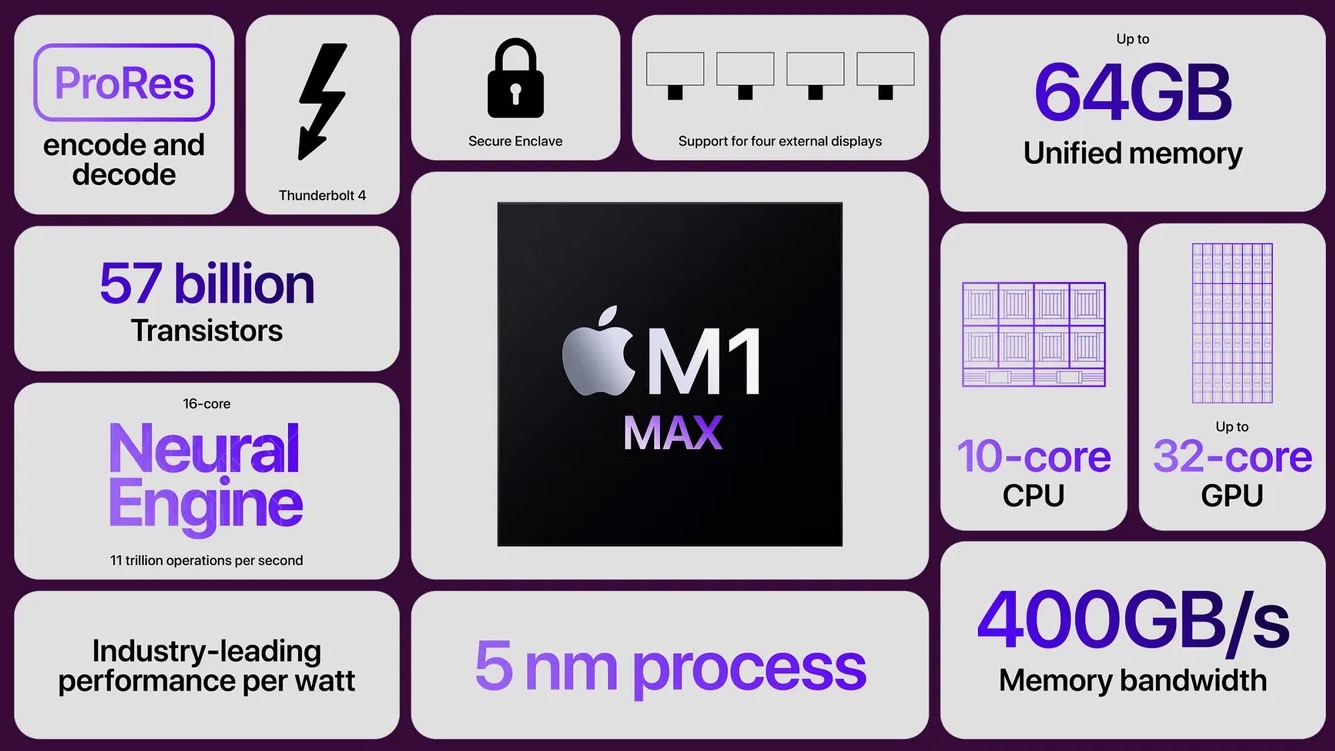Apple M1 Pro and M1 Max chips: Everything you need to know

After months of rumors and speculation, Apple finally revealed the M1 Pro and M2 Max chips in October 2021. The M1 Pro and M1 Max are built on the power and efficiency gains of the Apple M1 chip. They represent a significant jump in performance that will please "Pro" customers whose needs weren't quite met by M1.
Found in the 2021 MacBook Pro models, the updated chips are more powerful than the 2020 M1 chip and opened up new possibilities for the Mac lineup. The M1 Max is also found in the 2022 Mac Studio. However, Apple's not likely to introduce new Macs featuring the M1 Pro or M1 Max — although it's certainly possible.
What is the M1 Pro chip?

M1 Pro is based on a 5nm architecture with 22.7 billion transistors, more than double that of the M1. It features up to 10 CPU cores, including eight high-performance cores, for 70% faster performance than M1.
On the GPU side, M1 Pro offers a GPU with up to 16 cores, eight more than M1, for 2x faster graphics, as well as a 16-core Neural Engine, a ProRes accelerator, and a powerful media engine. You can edit multiple instances of both 4K and 8K videos with it.
You can configure the M1 Pro with up to 32GB of unified RAM and up to 200GB/s of memory bandwidth, double that of the M1 chip. M1 Pro offers support for up to two external displays.
What is the M1 Max chip?

Apple didn't stop at the M1 Pro, continuing to pump the power upward, with the M1 Max offering twice the power. The M1 Max chip features 57 billion transistors and was Apple's largest chip until it launched the M1 Ultra for the Mac Studio. The Apple M1 Max features the same 10-core CPU and 16-core Neural Engine as the M1 Pro, with a GPU featuring as many as 32 cores. It also has a more robust media engine and two ProRes accelerators, making it the ideal chip if you work with high-def video.
It offers up to 64GB of integrated RAM and doubles the memory interface of the M1 Pro with a bandwidth of up to 400 Gb/s. In addition, if you plan to hook your device up to multiple displays, M1 Max can support up to four with no problems.
iMore offers spot-on advice and guidance from our team of experts, with decades of Apple device experience to lean on. Learn more with iMore!
How do the M1 Pro and M1 Max chips differ from the M1 chip?
Here's a summary of how the M1 Pro and M1 Max chips differ from the M1:
| Header Cell - Column 0 | M1 | M1 Pro | M1 Max |
|---|---|---|---|
| Transistors | 16 billion | 33.7 billion | 57 billion |
| CPU cores | 8 cores | 8 or 10 cores | 10 cores |
| GPU cores | 7 or 8 cores | 14 or 16 cores | 24 or 32 cores |
| Unified memory support | 8GB or 16GB | 16 or 32GB | 32 or 64GB |
| Memory bandwidth | up to 68.25 GB/s | Up to 200 GB/s | Up to 400 GB/s |
Which devices run Apple's M1 Pro and M1 Max chips?
Here are the only Apple devices that offer the M1 Pro and M1 Max, respectively:
- Apple M1 Pro: 14-inch MacBook Pro (2021), and 16-inch MacBook Pro (2021)
- Apple M1 Max: 14-inch MacBook Pro (2021), 16-inch MacBook Pro (2021), and Mac Studio (2022)
What is the M2 chip series?

At the Worldwide Developers Conference (WWDC) in June, Apple introduced the 13-inch MacBook Pro and MacBook Air versions. Both feature the all-new M2 chip and are among the best Macs today. However, while much better than the M1 chip, this chip wasn't designed to compete with the more powerful M1 Pro and M1 Max.
For example, the M2 offers 20 billion transistors vs. the 16 billion found on the M1. The M2 also provides more memory than the M1, up to 32GB vs. up to 16GB, respectively.
Since it announced the M2, Apple's likely to never again launch a new product with the M1 Pro or M1 Max chip; instead, next-generation Macs, including the 2022 14-inch and 16-inch MacBook Pro models, should feature the M2 Pro and M2 Max chips.
Still powerful though not new
The Macs that feature the M1 Pro and M1 Max should be around for many years and offer incredible power and reliability. So, it will be long before either of these chips feel old and need to be replaced — no need to worry! However, of course, if you want the latest and greatest Apple has to offer the new MacBook Air and MacBook Pro with M2 is the way to go.

Bryan M. Wolfe has written about technology for over a decade on various websites, including TechRadar, AppAdvice, and many more. Before this, he worked in the technology field across different industries, including healthcare and education. He’s currently iMore’s lead on all things Mac and macOS, although he also loves covering iPhone, iPad, and Apple Watch. Bryan enjoys watching his favorite sports teams, traveling, and driving around his teenage daughter to her latest stage show, audition, or school event in his spare time. He also keeps busy walking his black and white cocker spaniel, Izzy, and trying new coffees and liquid grapes.
